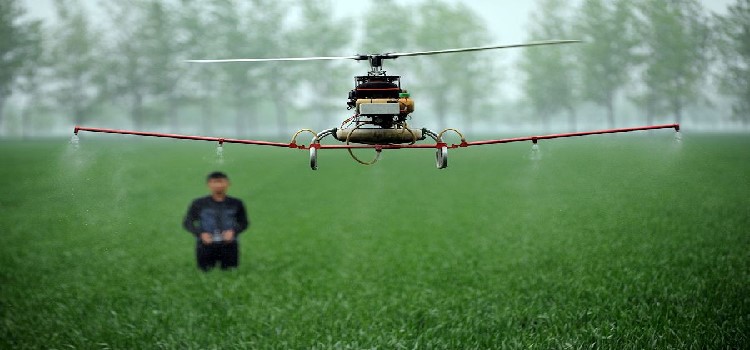
Canada Agriculture Robots Market by Type (Driverless Tractors, Unmanned Aerial Vehicles (UAVs), Milking Robots, Automated Harvest Robots, and Others), Offering (Hardware, Software, and Services), Farming Type (Indoor Farming and Outdoor Farming), Application (Dairy Management, Irrigation Management, Harvest Management, Soil Management, Inventory Management, and Others), and End User (Field Crops, Fruits & Vegetables, Livestock, and Others) – Opportunity Analysis and Industry Forecast 2023–2030
Industry: Agriculture | Publish Date: 15-Oct-2024 | No of Pages: 87 | No. of Tables: 72 | No. of Figures: 31 | Format: PDF | Report Code : AG617
Market Definition
Canada Agriculture Robots Market size was valued at USD 178.54 million in 2022, and is predicted to reach USD 666.36 million by 2030, with a CAGR of 16.7% during the forecast period, 2023–2030. Agrirobots are the agricultural robots that perform specific tasks like planting, spraying, monitoring, or harvesting crops using mechanical arms or specialized tools.
They navigate through fields using GPS and mapping technologies, adapting their routes if needed. Many agrirobots can operate autonomously, continuously performing tasks without constant human intervention. They collect and analyze data during their operations, providing valuable insights for farmers to make informed decisions about farm management practices. By automating tasks and optimizing resource utilization, agrirobots contribute to increased efficiency and productivity in agriculture. By utilizing sensors such as cameras, LiDAR, and GPS, agricultural robots gather data about the environment, including factors like crop conditions and obstacles. This data is then processed through algorithms and artificial intelligence systems to derive meaningful insights and make informed decisions.
Growing Adoption of Agriculture Robots in Canada's Farming Industry
Canada is the second U.S. agricultural export market, with wood pellet exports expected to grow five percent on increased demand. In response to this trend, there has been a notable surge in the adoption of agriculture robots in Canada's farming industry, which is expected to drive the growth of the agribots industry in the country.
The Carbon Robotics LaserWeeder and the Lygus BugVac are instances of robots that excel in tasks such as weed removal and pest control. The LaserWeeder employs lasers to eliminate weeds, while the BugVac is a self-driving vacuum robot designed specifically for pest control. Additionally, these robots demonstrate advanced capabilities in crop scouting, weed control, and harvesting.
Increasing Growth in Agribots Market with Advanced Solutions
The agribots market is experiencing growth driven by an increasing number of product releases by market players focused on simplifying and accelerating the milking process in the agricultural industry. These innovative solutions aim to address the challenges faced by farmers in milking operations, such as labor-intensive processes and time constraints. Agribots designed for milking tasks are equipped with advanced technology and features that optimize the milking process, improve efficiency, and ensure the well-being of livestock.
Thus, it is expected to create significant growth in the agriculture robots market. For instance, in August 2021, Clearpath Robotics introduced the next generation of its DairyRobot R9500 and DairyProQ automated milking systems, bringing major upgrades to the milking technology. These systems offer benefits like the In-Liner Everything milking and MilkRack milking unit, among others.
The High Initial Investment Required for Acquiring and Implementing Agriculture Robots
The substantial initial investment needed to acquire and deploy agriculture robots in Canada poses a significant challenge for many farmers, particularly those operating on smaller scales or with limited financial resources. This investment includes not only the cost of purchasing the robots but also the infrastructure and equipment required to effectively utilize them. As a result, the high upfront costs act as a restraining factor for the market growth in the country.
Enhancing Crop Quality and Efficiency through Agrirobots
Canada's greenhouse industry is growing, especially for high-value crops like fruits and vegetables. Therefore, robots can assist in greenhouse automation by managing tasks such as seeding, transplanting, monitoring plant health, and adjusting environmental conditions. Automated systems can optimize lighting, temperature, humidity, and nutrient delivery, resulting in improved crop quality, reduced resource consumption, and increased production efficiency. Thus, it is expected to create ample opportunity for the market.
Competitive Landscape
The agriculture robots industry includes several market players such as Deere & Company, Rockwell Automation Inc., CNH Industrial Capital LLC, GEA Group, Naio Technologies, Boumatic Robotics, DeLaval, SZ DJI Technology Co., Ltd., Ecorobotix SA and Trimble Inc.. These market players are adopting various strategies such as innovation and collaboration to maintain their dominance in the market of Canada.
For instance, in June 2022, Solinftec teamed up with the University of Saskatchewan to unveil its new AgTech robotic platform in Canada. The goal is to provide farmers and agronomists with advanced information that will result in increased yields, more efficient use of resources, reduced environmental impact, and help meet the growing global demand for food.
Key Benefits
-
The Canada agriculture robots market report provides a quantitative analysis of the current market and estimations through 2023-2030 that assists in identifying the prevailing market opportunities to capitalize on.
-
The study comprises a deep dive analysis of the market including the current and future trends for depicting the prevalent investment pockets in the market.
-
The information related to key drivers, restraints, and opportunities and their impact on the market is provided in the report.
-
The competitive analysis of the market players along with their market share in the Canada agriculture robots market.
-
The SWOT analysis and Porter’s Five Forces model are elaborated in the study.
-
Value chain analysis in the market study provides a clear picture of the stakeholders’ roles.
Canada Agriculture Robots Market Key Segments
By Component
-
Driverless Tractors
-
Unmanned Aerial Vehicles (UAVs)
-
Milking Robots
-
Automated Harvest Robots
-
Others
By Offering
-
Hardware
-
Software
-
Services
By Farming Type
-
Indoor Farming
-
Outdoor Farming
By Application
-
Dairy Management
-
Irrigation Management
-
Harvest Management
-
Soil Management
-
Inventory Management
-
Others
By End User
-
Field Crops
-
Fruits & Vegetables
-
Livestock
-
Others
Key Players
-
Deere & Company
-
Rockwell Automation Inc.
-
CNH Industrial Capital LLC
-
GEA Group
-
Naio Technologies
-
Boumatic Robotics
-
DeLaval
-
SZ DJI Technology Co., Ltd.
-
Ecorobotix SA
-
Trimble Inc.




 Speak to Our Analyst
Speak to Our Analyst

































